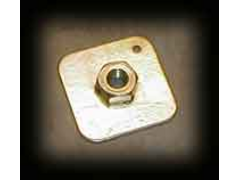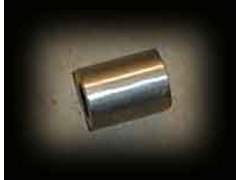Caber


I seem to have a conflict on the book drawings between the outside seat belt mounting plates and the trailing arm brackets. If I build as per book I
can't see how i can get in to tighten the seatbelt mounting nuts or even get them in as the lower trailing arm bracket is in the way. Am I doing
something really stupid to arriva at this problem?
Caber
Common practice is to weld the nuts to the re-inforcing plates but I don't really see where your access problem is.
The diagram on pg 58 seems fairly self explanatory.....or have I mis-understood 
Mick
SVA requirement the seatbelts must only need to be assembled from one side --- ie a captive nut of some form must be used. Anchorage fittings with
suitable threads are sold by most suppliers in the Locost biz


Rescued attachment nut-plate.jpg
or


Rescued attachment seat-belt-boss-weld-on.jpg
Problem is on rhe other side of the blue sheet. the lower trailing arm mount is in the same place so you have a not for the trailing arm bolt more or
less in the same place as the nut for the seatbelt! This is more troublesome if you want to use 70mm bolts in the brackets to make sure you have
threads showing through the nylocks! 65 mm bolts seem non existant and 60s are too short!
Also don't you have to weld all around the seatbelt plate for Mr SVA? the blue plate which is actually the inner wheel arch needs to go in after
and be welded to the top of the seatbelt mounting no?
Caber
Yes, I would agree that the seat belt mount should be welded directly to the chassis members and the wheel arch 'infill' panel be welded to
it.
There still seems to be plenty of room to locate a 7/16" nut for the harness fixing though.
Unless I'm being thicker that usual 
Mick
Howto shorten a bolt --
Require plain nut (2 off) , standard hacksaw with 24 or 30 tpi hss blade, vice, flat file.
Wind one nut on to bolt past the point the bolt is to be shortened to. Cut bolt to length with hack saw -- I use the nut as guide to keep the
blade vertical and true. Unscrew the nut a bit then wind back on, file wrags off end of thread and repeat until you can screw the second nut on
easily without cross threading.
If you have a suitable hex die nut or "thread repairer" file you can also use these to clean te thread up.
[Edited on 8/1/06 by britishtrident]
Yes I know how to shorten a bolt however I intend to use BZP and I don't know how to restore the zinc plating on the cut end! I have messed with
enough rusty bolts on Land Rovers to have developed a distinct aversion to rusty bolts particularly over length! I also do not want to use stainless
bolts in critical applications particularly on the suspension!
I think that this car is likely to get taken to bits and put together a few times so the better the nuts and bolts the easier it willbe in the
future!
Caber
quote:
Originally posted by caber
Yes I know how to shorten a bolt however I intend to use BZP and I don't know how to restore the zinc plating on the cut end! I have messed with enough rusty bolts on Land Rovers to have developed a distinct aversion to rusty bolts particularly over length! I also do not want to use stainless bolts in critical applications particularly on the suspension!
I think that this car is likely to get taken to bits and put together a few times so the better the nuts and bolts the easier it willbe in the future!
Caber

Copper grease neither BZP
Neither help much if at all.
Coppaslip is known as special seizing compound among ships engineers, and zinc plating only gives you zinc oxide as well as ferrous oxides.
quote:
Originally posted by britishtrident
Copper grease and BZP
Neither help much if at all.
Coppaslip is known as special seizing compound among ships engineers, and zinc plating only gives you zinc oxide as well as ferrous oxides.
I've used copper slip for years on e.g. suspension bolts (mini rear subframes spring to mind!), and especialy on the hubs of alloy wheels and have never had any trouble with corrosion afterwards.
I hope not to be taking my locost to sea! I will be using copper slip it has worked a treat on my land Rovers however long exposed threads not plated
are the real bugger to undo I have sheared many over the years, when the corroded section of thread gets into the nut they jam real tight. On older
land rovers many of the nuts and bolts have a dark grey passivsation treatment that seems to work exceptionally well, particularly in contact with
aluminium, I have never figured out what it is but it does work!
Caber
[Edited on 1/10/2006 by caber]
I find wire brushing thread exposed through a nut before trying to undo it helps if you can get at it. As for the position, move it back a couple of inches from where you are looking now, it's not going to affect anything that much. Use your discretion, as long as your belt goes over your lap. My belts are through the floor behind the seat and it passed SVA, as long as it complies there are endless possibilities. I used nyloc nuts not welded to the floor so as long as you can get at both sides they are o.k. not like a saloon where the nut is inside the sill usually.
While we`re on the subject guys I`ve put my bottom seatbelt anchor on the right angle which is the next one forward. Any probs with this?.........I
sounded like a real
Chav there.
Alex